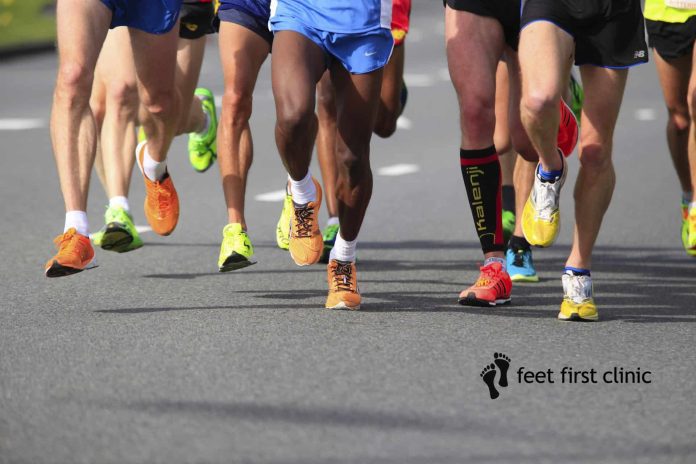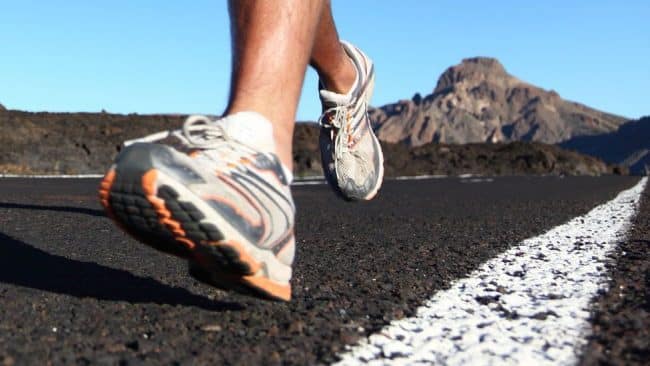Runners need specialized shoes to enhance their performance and prevent injuries. These shoes are designed with features that cater to the specific needs of runners, such as cushioning, stability, and support. They provide optimal shock absorption, reducing the impact on joints and muscles during repeated pounding on hard surfaces. With the right pair of shoes, runners can maintain proper alignment and foot motion, improving their efficiency and reducing the risk of overpronation or supination. Whether you are a professional athlete or an occasional jogger, investing in specialized running shoes can make a significant difference in your running experience.
Review contents
The Importance of Proper Footwear for Runners
As avid runners ourselves, we understand the significance of wearing the right shoes during our runs. The right footwear not only enhances our performance, but it also helps prevent injuries and ensures our overall comfort. In this article, we will delve into the various aspects of proper footwear for runners and discuss why it is crucial for every runner to invest in specialized shoes.
Running Mechanics
Before we dive into the importance of proper footwear, it is essential to understand the mechanics of running. Running involves a complex series of movements that directly impact our bodies. Each step we take while running creates various forces that are transmitted through our feet, legs, and entire musculoskeletal system.
Impact Forces
One of the most critical aspects to consider when choosing running shoes is their ability to absorb and disperse impact forces. When we run, our feet hit the ground with a certain amount of force, known as ground reaction forces. The impact forces can be significant, especially when running on concrete or other hard surfaces.
Biomechanical Variations
Runners come in all shapes, sizes, and with different biomechanics. It is important to recognize that not all runners have the same gait or foot strike pattern. Understanding and addressing these biomechanical variations is crucial for injury prevention and overall comfort.
Injury Prevention
Injury prevention is a primary concern for runners, as the repetitive nature of running can put strain on various parts of the body. Proper footwear plays a significant role in minimizing the risk of injuries. Let’s explore some common running injuries and how proper footwear can help prevent them.
Understanding Running Mechanics
Foot Strike Patterns
Foot strike patterns refer to how our feet come into contact with the ground while running. The three main foot strike patterns are heel strike, midfoot strike, and forefoot strike. Each pattern has its own impact on the body and requires a specific type of shoe to support and cushion the foot accordingly.
Pronation and Supination
Pronation and supination are natural movements of the foot that occur during the running gait cycle. Pronation is the inward rolling motion of the foot, while supination is the outward rolling motion. Both movements are necessary for shock absorption and stability, but excessive pronation or supination can lead to various injuries.
Running Gait
Running gait refers to the overall pattern of movement that a runner exhibits while running. It includes factors such as stride length, cadence, foot strike pattern, and arm swing. Analyzing and understanding our running gait can help us choose the right footwear that caters to our individual needs.
Impact Forces and Cushioning
Ground Reaction Forces
Ground reaction forces refer to the force exerted by the ground on our feet when we run. The impact forces during running can be several times our body weight. The right running shoe must be able to absorb and distribute these forces effectively to minimize the strain on our joints and muscles.
Shock Absorption
Shock absorption is a crucial element in proper running footwear. Shoes with adequate shock absorption capabilities help reduce the stress placed on our feet, ankles, knees, and hips. This, in turn, decreases the risk of injuries such as stress fractures and joint pain.
Midsole Cushioning
The midsole of a running shoe is where the majority of the cushioning and support is provided. Different shoes offer varying levels of cushioning, which affects the overall feel and comfort during a run. Finding the right balance of midsole cushioning is important to suit individual preferences and needs.
Heel-to-Toe Drop
Heel-to-toe drop, or simply “drop,” refers to the difference in height between the shoe’s heel and toe. It is often measured in millimeters. Different runners may have different preferences for the drop of their shoes, depending on their biomechanics and foot strike patterns.
Addressing Biomechanical Variations
Overpronation
Overpronation occurs when the foot rolls excessively inward during the foot strike and midstance phases of running. This can lead to various injuries, such as plantar fasciitis and shin splints. Stability shoes with motion control features are often recommended for runners with overpronation.
Underpronation
Underpronation, also known as supination, is when the foot rolls outward during the foot strike and midstance phases of running. This foot strike pattern can cause increased stress on the outer edges of the foot and lead to conditions such as ankle sprains and IT band syndrome. Neutral or cushioned shoes are typically recommended for runners with underpronation.
Neutral Pronation
Neutral pronation is considered the ideal foot strike pattern, where the foot rolls slightly inward upon landing and absorbs shock efficiently. Runners with neutral pronation have more flexibility in choosing their footwear. They can opt for a wide range of neutral cushioned shoes that cater to their comfort and performance needs.
Arch Support and Stability
Arch support plays a crucial role in providing stability and preventing excessive pronation or supination. Runners with high arches or flat feet often require additional arch support to maintain proper alignment and reduce the risk of injuries. Shoes with built-in stability features are designed to cater to these specific needs.
Injury Prevention and Support
Plantar Fasciitis
Plantar fasciitis is a common overuse injury that causes pain and inflammation in the plantar fascia, a thick band of tissue that runs along the bottom of the foot. Proper footwear with adequate arch support and cushioning can help alleviate the symptoms of plantar fasciitis and reduce the risk of further damage.
Achilles Tendinitis
Achilles tendinitis is characterized by inflammation of the Achilles tendon, which connects the calf muscles to the heel bone. It can be caused by improper footwear and overuse. Well-cushioned shoes with proper heel support and a gradual heel-to-toe drop can help reduce strain on the Achilles tendon and alleviate pain.
Shin Splints
Shin splints, or medial tibial stress syndrome, refers to pain along the shinbone or tibia. It is often caused by overuse and repetitive stress on the lower leg. Choosing shoes with adequate shock absorption and cushioning can help reduce the impact on the shins and prevent the development of shin splints.
Stress Fractures
Stress fractures are small cracks in the bones, commonly occurring in the feet and lower legs. They are often caused by repetitive stress and overuse. Supportive and cushioned shoes play a vital role in preventing stress fractures by absorbing shock and reducing the impact on the bones.
Ankle Support
Ankle injuries are prevalent among runners, especially those who participate in trail running or uneven terrain. Shoes with proper ankle support can provide stability and reduce the risk of ankle sprains. High-top or mid-top trail running shoes are specifically designed to offer added ankle support and protection.
Footwear Technology
Many specialized running shoe brands invest heavily in research and development to incorporate innovative technologies into their footwear. These technologies aim to enhance cushioning, stability, responsiveness, and overall performance. Features such as carbon fiber plates, energy return foams, and breathable upper materials contribute to an improved running experience.
Choosing the Right Type of Running Shoe
Road Running Shoes
Road running shoes are designed for running on hard, paved surfaces. They typically feature cushioning, responsiveness, and durability to withstand the repetitive impact of road running. These shoes often have a smooth sole to provide traction on asphalt or concrete.
Trail Running Shoes
Trail running shoes are designed specifically for off-road running on uneven and rugged terrain. They offer increased traction, durability, and protection from rocks, roots, and other obstacles. Trail shoes typically have a more aggressive lug pattern on the outsole and provide stability for uneven surfaces.
Race Shoes
Race shoes, as the name suggests, are lightweight and designed for racing or running at a fast pace. They prioritize speed and responsiveness over cushioning and comfort. These shoes are ideal for shorter distances or experienced runners who seek an edge in competition.
Minimalist Shoes
Minimalist shoes aim to mimic barefoot running by providing minimal cushioning and support. They allow for a more natural range of motion and foot strengthening. However, they require a gradual transition period and are not suitable for all runners or long-distance running.
Maximalist Shoes
Maximalist shoes, on the other hand, are designed with extra cushioning to provide a plush and comfortable feel. They are ideal for runners who prefer added protection and shock absorption during longer runs or those with a history of injuries. Maximalist shoes are especially popular among ultra-marathoners.
Cross-Training Shoes
Cross-training shoes are designed for a variety of activities, including running, weightlifting, and gym workouts. While they may not provide the same level of cushioning and support as dedicated running shoes, they offer versatility and stability for different types of training.
Factors to Consider When Buying Running Shoes
Foot Type and Pronation
Understanding your foot type and pronation is crucial in selecting the right running shoes. Whether you have high arches, flat feet, or neutral arches, it is important to choose a shoe that provides adequate support and complements your natural foot mechanics.
Heel Fit and Support
The heel fit of a running shoe determines how well it secures your heel in place during each stride. A snug, yet comfortable, heel fit prevents slippage and helps maintain proper alignment. Look for shoes with secure lacing systems and heel counters that provide stability and support.
Toe Box Space
The toe box space refers to the room available for your toes to splay and move comfortably within the shoe. Squeezed toes can lead to discomfort, blisters, and black toenails. Ensure that the shoe offers ample toe box space to accommodate the natural movement of your toes.
Arch Support and Cushioning
The level of arch support and cushioning you require depends on your foot type and preferences. Those with high arches may benefit from added arch support, while runners with flatter feet might find cushioned shoes more comfortable. Strike a balance that provides adequate support without sacrificing comfort.
Weight and Flexibility
The weight and flexibility of a running shoe can greatly impact your overall running experience. Lighter shoes can contribute to a faster pace, while more flexible shoes allow for a natural range of motion. Consider your running goals and preferences when choosing between lighter, more flexible shoes and those with more structure and stability.
Breathability and Moisture Wicking
When you’re out for a run, your feet inevitably generate heat and sweat. Shoes with breathable and moisture-wicking materials help keep your feet cool and dry, reducing the risk of blisters and discomfort. Look for shoes with mesh or perforated uppers that promote airflow and moisture evaporation.
Durability
Durability is an important factor to consider, especially if you’re a frequent runner or plan to log high mileage. Running shoes undergo significant wear and tear over time, so it’s essential to choose a shoe that can withstand the demands of your running routine. Look for shoes with durable outsoles and reinforced materials.
The Role of Specialized Running Shoe Brands
Nike
Nike is known for its extensive line of running shoes that cater to various running styles and preferences. Their innovative technologies, such as Nike Zoom Air and Nike React foam, offer responsive cushioning and energy return. Nike has made significant contributions to the running community with its continuous focus on performance-enhancing footwear.
Adidas
Adidas is a renowned brand in the running world, offering a wide range of running shoes for different terrains and running styles. Their Boost technology, made from thousands of energy capsules, delivers high responsiveness and energy return. Adidas shoes often feature a sleek design and combine functionality with style.
Brooks
Brooks has established itself as a trusted brand in the running community, consistently producing high-quality running shoes that focus on comfort and performance. Known for their BioMoGo DNA and GuideRails technologies, Brooks shoes provide adaptive cushioning and stability to support a runner’s individual needs.
New Balance
New Balance is a brand that prides itself on its commitment to excellent craftsmanship and technological advancements. They offer a diverse range of running shoes that cater to different foot types and pronation patterns. New Balance shoes often feature supportive midsoles, durable outsoles, and a comfortable fit.
Saucony
Saucony is dedicated to creating shoes that allow runners to unlock their full potential. Their shoes focus on providing a lightweight, responsive, and comfortable ride. With cushioning technologies like EVERUN and PWRFOAM, Saucony offers options for runners seeking a balance of comfort and performance.
Asics
Asics has been a staple in the running community for decades, producing high-quality running shoes known for their reliability and durability. Asics incorporates their GEL cushioning technology into many of their models, providing excellent shock absorption and cushioning. Their shoes often feature a supportive and comfortable fit for all types of runners.
Hoka One One
Hoka One One is a brand that has gained popularity for its maximalist approach to running shoes. Their shoes feature oversized midsoles that provide exceptional cushioning and shock absorption. Hoka One One offers a unique running experience with their lightweight, yet highly cushioned shoes that benefit a wide range of runners.
Replacing and Maintaining Running Shoes
Mileage and Shoe Lifespan
Running shoes have a lifespan, typically measured in miles, due to the wear and tear they endure. On average, running shoes last between 300 to 500 miles, depending on factors such as your running style, body weight, and the terrain you typically run on. Keep track of your mileage and consider replacing your shoes when they show signs of wear.
Signs of Wear and Tear
Pay attention to signs of wear and tear on your running shoes. This can include worn outsoles with reduced traction, compressed midsoles that no longer provide adequate cushioning, or visible tears or rips in the upper material. These signs indicate that your shoes have reached the end of their lifespan and should be replaced.
Rotating Shoes
Rotating shoes is a common practice among runners, especially those with high mileage routines. By alternating between two or more pairs of running shoes, you allow one pair to fully recover and decompress between runs. This extends the lifespan of each pair and ensures consistent cushioning and support.
Cleaning and Drying
Proper maintenance of your running shoes can also prolong their lifespan. Cleaning your shoes regularly helps remove dirt and debris that can contribute to wear. Use a mild detergent and a soft brush to scrub off any stains and rinse thoroughly. After cleaning, ensure your shoes are completely dry before wearing them again to prevent odor and moisture-related issues.
The Influence of Running Surface
Road Running
Road running is the most common type of running, and it involves running on paved surfaces such as asphalt or concrete. The hard surface of the road places a higher impact on your feet and joints compared to softer surfaces. When choosing shoes for road running, prioritize cushioning, shock absorption, and durability.
Trail Running
Trail running involves running on uneven, unpaved terrains such as dirt paths, forest trails, or rocky surfaces. The varied terrain requires shoes with excellent traction, stability, and protection. Look for trail running shoes that have a grippy outsole, a protective toe cap, and a durable upper.
Track Running
Track running takes place on well-maintained, synthetic surfaces specifically designed for track and field events. Track running shoes are lightweight, flexible, and often have spikes or rubber studs for traction. These shoes prioritize speed, responsiveness, and grip on the track surface.
In conclusion, proper footwear plays a crucial role in the comfort, performance, and injury prevention of runners. Understanding your running mechanics, impact forces, and biomechanical variations allows you to choose the right type of running shoe for your needs. Factors such as pronation, cushioning, arch support, and stability must be considered to ensure your footwear adequately supports and protects your feet. Take the time to find a reputable brand that specializes in running shoes and aims to continuously improve the running experience. Remember to replace your shoes when they show signs of wear and tear, and maintain them properly to extend their lifespan. By considering your running surface and choosing shoes specifically designed for it, you can further optimize your running experience and reduce the risk of injuries. So, lace up your proper footwear and hit the road, trails, or track with confidence!













